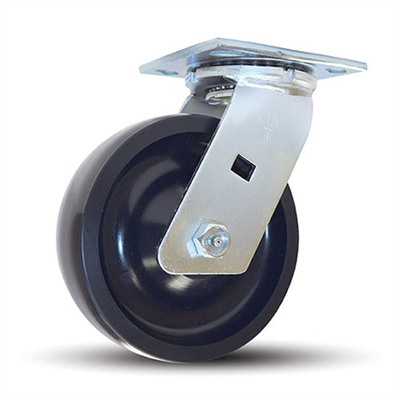The choice between rigid and swivel casters depends on the specific requirements of your application, and often, a combination of both types is used to achieve the desired balance between stability and maneuverability. Here’s a comparison to help you decide when to use rigid casters and when to use swivel casters:
Rigid Casters:
- Stability: Rigid casters are ideal when stability is a top priority. They maintain a straight-line path, making them excellent for applications where you want to minimize unintended changes in direction.
- Straight-Line Movement: Use rigid casters when you need to move an object or equipment in a single, fixed direction without swiveling or pivoting.
- Heavy Loads: Rigid casters can handle higher weight capacities compared to swivel casters because they lack the swiveling mechanism, making them suitable for moving heavy loads.
- Precision Control: When you require precise control over the direction of movement, rigid casters are the right choice. They provide accuracy and control for applications like manufacturing, robotics, or industrial machinery.
- Reduced Maintenance: Rigid casters generally require less maintenance because they have fewer moving parts than swivel casters.
- Reduced Noise and Vibration: Rigid casters tend to produce less noise and vibration compared to swivel casters. This makes them suitable for applications where a quieter or vibration-free environment is required.
Swivel Casters:
- Maneuverability: Swivel casters excel in applications that require frequent changes in direction or tight maneuverability. They can rotate 360 degrees, allowing for easy turning and navigating around obstacles.
- Versatility: Swivel casters are versatile and can move in any direction, making them suitable for a wide range of applications, including carts, dollies, office chairs, and more.
- Tight Spaces: When you need to navigate through narrow aisles or tight spaces, swivel casters are a better choice because they can change direction effortlessly.
- Reduced Pushing/Pulling Force: Swivel casters reduce the effort required to change the direction of movement, making them suitable for manual applications where ease of use is crucial.
- Combining with Rigid Casters: In many cases, a combination of rigid and swivel casters is used. Rigid casters are placed on one end of an object to provide stability, while swivel casters are placed on the other end to allow for easy steering and maneuverability.
- Increased Mobility: Swivel casters are often found on items like shopping carts, office chairs, and hospital beds, where the ability to move in multiple directions is essential.
Ultimately, the decision between rigid and swivel casters will depend on the specific requirements of your application, load capacity, and the environment in which they will be used. Keep in mind that caster selection should be made based on a balance between stability and maneuverability, and in some cases, you may need both types of casters to achieve the desired functionality.


